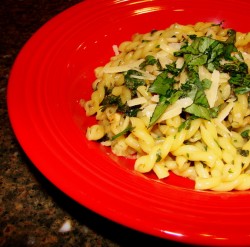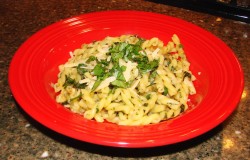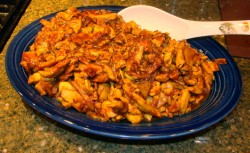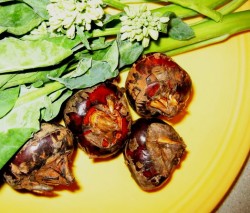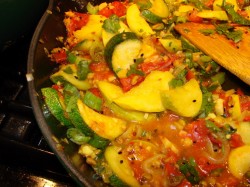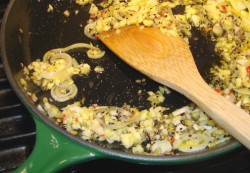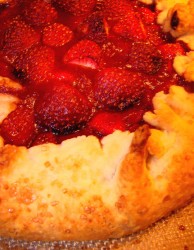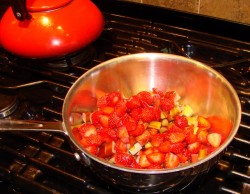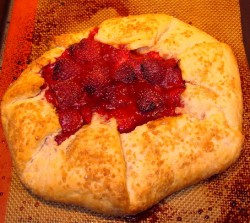Food In The News: Chocolate, Recipes on the ‘Net and Farmers Who Write
The New York Times has an interesting trio of articles on subjects of chocolate, recipes, the internet and farmers this week.
First up, the Times has an Op-Ed piece by Mort Rosenblum, author of Chocolate: A Bittersweet Saga of Dark and Light, on the proposed new regulations which will allow chocolate manufacturers to replace a small amount of cocoa butter in their products with other, less expensive fats. This would allow the chocolate makers to sell the more valuable cocoa butter, which is the natural fat inherent to cocoa beans, to cosmetic makers.
Currently, products labelled “chocolate” must contain cocoa butter; other fats can be added, but cocoa butter cannot be removed. Cocoa butter is considered an essential component of chocolate, because it is the ingredient which gives chocolate its ability to melt in the mouth; it is the ingredient responsible for the creamy, lush mouthfeel for which chocolate is justly famous.
The proposed legislation has struck a nerve among American chocophiles, and a debate rages on the net on the subject of what chocolate is and what it should be.
Next, in an article entitled, “Readers Are Key Ingredient as Virtual Kitchen Heats Up”, we are told that one of the most popular single activities enjoyed by women online is simple recipe searches. Apparently, when people seek a recipe these days, they are more likely to use the internet instead of turning to cookbooks, magazines or newspapers.
And one of the things that women seem to really like about internet recipe databases is the sense of community that they bring to the table when message boards and comments are included as features.
Now, any food blogger could have told folks this; the best part of writing Tigers & Strawberries for me has been that I have met people from all around the world who love food and love writing about it and talking about it. I have had the chance to share recipes with people from cultures far removed from my own, and have learned something which I have always suspected: that culture is carried by food, by our relationship with food and by our thoughts and feelings about food.
But there are neat developments in the works on the web for recipe sharing:epicurious.com is starting a service called “My Epi,” which is essentially Facebook for the food obsessed. With this tool, one can create profiles that list interests and share information with other like-minded cooks.
Pretty fun stuff.
Of course, the downside to all this fun is that advertisers are hanging out, trying to make a buck off of all this recipe sharing and food talk. I guess they have to figure out a way to get to folks like me who avoid commercial television, don’t bother to look at ads in magazines and read my newspapers online. And I suppose I don’t begrudge them that, since I will ignore them just as easily online as I do everywhere else, except when I examine their work just to wonder, “Do they think that will really work on someone?”
Finally, the New York Times tells us that farmers don’t just grow vegetables and milk cows, they also write books. Somehow, “Old MacDonald Now Has a Book Contract” manages to discuss the newly popular genre of nonfiction books, articles, newsletters and other prose offerings written by small farmers in a way that avoids the trap of an urban journalist condescendingly wondering at the fact that rural folks manage not only to be literate, but also articulate.
Which is good, because the article also points out a very germane fact: both good farmers and good writers are excellent observers, and it stands to reason that if one can take note of details in the natural world and then convey them intelligently in words to a reader, there are bound to be readers interested in what that observer has to say.
I find that the fact that Americans are becoming interested enough in food and where it comes from to read books from small farmers who are actually doing the hard work of producing food and then doing the hard work of writing passionately about it to be heartening. It means that we are taking steps toward valuing the food which sustains us more highly than just as fuel. We are seeing it as it rightly is: a part of ourselves, our culture and our way of life.
That gives me hope for the future.
When Ingredients Really Matter: Simple Summer Pastas
I am always a believer in using the best, freshest, most flavorful ingredients I can afford, preferably locally grown. Locally grown foods are not only politically, economically and ecologically sound additions to our diets, they are also tastier and more nutritious as well.
Vegetables, fruits and herbs which are picked just before you eat them have more of their nutrients left; those which have been picked and shipped from far away lose their nutritive qualities quickly. (In my opinion, you are better off eating frozen vegetables than most of the ones fround in your local grocery store that have traveled thousands of miles–the frozen ones were frozen not long after they were picked; the “fresh” ones often were picked more than a week before they get to you.)
My insistence on the freshest ingredients goes into overdrive, however, when I am a making a very simple dish which relies upon the quality of every single component. When cooking something that is made with only a handful of ingredients, and which relies upon a minimum of flavors and very simple cookery techniques which transform these ingredients as little as possible, it really is imperative to start out with the best of the best.
Using the best one can afford keeps simple foods from tasting boring or flat.
I am especially fanatic about great ingredients when I set out to make a very simple summer pasta, like the one I made last night.
With a sauce based on onions caramelized in butter and olive oil, sauteed fresh garlic and chilies, a splash of sherry and a heavy handful each of shredded parmesan cheese and minced fresh basil and Italian parsley, each ingredient should be the best that there is. There is simply no room in this recipe to hide low quality ingredients.
So this is the time to splurge on good olive oil and genuine parmesiano-reggiano cheese. This is the time to run out and pick a double handful of fresh basil from your garden, and mince it up right before you stir it into the pasta. This is the time to use fresh spring onions and garlic, because their flavors really shine.
I am lucky; the drought we have had for most of this winter and spring have made the onions, garlic and basil all exceptionally flavorful. The strawberries, blueberries and blackberries may not have appreciated the dry weather, but the herbs and other aromatics are among the most fragrant and delicious I have ever grown or bought here in Athens. The basil in our deck garden is huge, and lush–and you can smell it even before you have climbed the stairs all the way to the top where it grows in pots, overtaking their containers in wild abandon.
The scent wafts down on the slightest of breezes, spicy and redolent of green, tinged with the sweetness of licorice. This is some of the best basil I have grown–the lack of water has concentrated the essential oils that give the leaves of every variety their flavor. (I have two different types of Thai basil, two Italian basils, a Mexican basil and cinnamon basil all up on the deck.)
It is amazing stuff, really fresh basil, and it is deserving of the truly fresh garlic that I have been buying from Rich Tomsu. He grows many varieties of garlic, all of them good. I like the spicier German hardneck garlic he grows–it is robust and when just freshly dug, so full of sticky juice it is fairly bursting with flavor and scent. It is sexy and strong and oh so earthy–it tastes as deep and rich as Eartha Kitt’s voice.
Dan watched me make the pasta, which I whipped up on a whim, asking him to stay. It is a vegetarian meal, with the exception of one ingredient: a tiny amount of anchovy paste.(Here is a note: if you want to be totally vegetarian, replace the anchovy paste with some rehydrated dry porcini and shiitake mushrooms, minced finely, or some truffle paste or truffle oil.) I showed him how to make it, because it is so simple, and he was impressed with how quickly it went together. It seemed, in fact, like I had created dinner out of nothing: a pound of pasta, some butter and olive oil, onions, garlic, chilies, anchovy paste, a splash of wine, lemon zest and juice, fresh herbs and cheese. Surprised at how satisfying it was, he ate two bowls of it, and didn’t note the lack of meat at all.
None of us did. When the fresh vegetable ingredients are this good, and the pasta is of a high quality and is cooked al dente, meat is not missed.
There are almost endless variants one could make with this basic recipe. Change the herbs, change the cheese, add some shredded vegetables, a mixture of mushrooms, take out the lemon juice and use chicken or vegetable broth, add olives–fresh breadcrumbs or almonds or pine nuts–you get the picture. Change the pasta shape, use fresh pasta, use flavored pasta. It is all too much fun to imagine the possibilities.
Gemelli with Caramelized Onions and Herbs
Ingredients:
1 pound of gemelli pasta
2 tablespoons olive oil
3 tablespoons butter
2 1/2 cups thinly sliced spring onions or regular yellow onions
1 teaspoon salt
1/4 teaspoon anchovy paste
3 tablespoons fresh garlic, minced (about 4 large cloves)
fresh chilies to taste (I used three fresh thai bird chilies), minced
1 tablespoon freshly minced lemon zest (zest of one lemon)
1/4 cup sherry or marsala wine
2 tablespoons lemon juice
3/4 cup freshly grated parmesan cheese
3/4 cup packed freshly minced fresh basil leaves
1/4 cup packed freshly minced Italian parsley leaves
roughly 1/4 cup each grated parmesan cheese and minced herb leaves for garnish
Method:
Bring a large pot of water to a boil for the pasta.
Melt the butter with the olive oil in a wide, deep heavy-bottomed skillet on medium heat. Add the onions in a single layer and sprinkle with the salt. Cook, stirring constantly, until they are a deep golden brown.
Put the pasta in to cook, and cook until it is just barely al dente. It should be ever so slightly undercooked. Before draining it, scoop out about a cup of cooking water and reserve it. Drain the pasta.
Add the anchovy paste, garlic, chilies and lemon zest and cook for another few minutes, until the garlic turns golden and everything is fragrant. When the onions are totally broken down, deglaze the pan with the wine and allow the alcohol to boil off, stirring all the while. Add the lemon juice and the drained pasta, and some of the cooking water, as needed to mix the pasta with the caramelized onions.
Stir in the cheese and herbs, stirring as the cheese melts and incorporates into the pasta.
Serve immediately in warmed bowls, garnishing each portion with a sprinkle of cheese and herb bits.
The Secret’s In The Sauce: Sichuan Shredded Chicken With Garlic Sauce
The actual name of this dish translates to “Chicken in Fish-Fragrant Sauce,” but you will likely never see it on an American Chinese restaurant menu as such, for obvious reasons. That just doesn’t sound appetizing to the American imagination.
The sauce does not smell of fish–and there is no fish in it–it is simply a sauce that is traditionally used by cooks in Sichuan to give fish a delicious aroma.
The rich coffee-colored sauce is sweet and sour, spicy and garlicky, and is filled with the fragrance of fresh ginger, scallions, soy sauce and sesame oil. While it is traditionally used for fish, in most American restaurants that serve the foods of Sichuan province, this sauce, granted the more palatable, if inadequately descriptive moniker “Garlic Sauce,” is most often paired with shredded chicken, pork, beef or halved shrimp. I have also had it with fresh scallops–a truly decadent combination which I want to cook in my own kitchen sometime when Morganna is out for dinner, since she does not much care for scallops.
The only other traditional main ingredient besides the poultry, meat or seafood are water chestnuts and wood ear mushrooms. I was out of wood ears, which are just there for the contrasting color and wonderful squeaky-crunchy texture. but I had managed to pick up crisp, sweet and juicy fresh water chestnuts at the Columbus Asian Market the last time we were there.
Fresh water chestnuts are where its at for this dish. Even though I had only ever eaten it with canned water chestnuts before when I first fell in love with the dish back in Huntington, West Virginia at the China Garden Restaurant, once I made it myself with the fresh ones–there was no going back. The difference in flavor is just astounding–the intense sugary hit of the crisp little slivers of water chestnut contrast perfectly with the buttery tender chicken, and combine with the zingy sauce to make a divine cacophony of flavor and texture in the mouth. They are quite simply incomparable and are well worth seeking out. If you cannot find them, try fresh jicama root–it has the exact same crunch and is almost as sweet as a fresh water chestnut, but with a bit of a musky starchiness in addition to the sugar.
This dish is the very first real Chinese recipe I ever learned, you know. It is true–I learned it from one of the under-chefs who worked for the chef-owner of the China Garden, Huy. The chef’s name was Lo, and he loved me dearly, and would teach me various things about Chinese food. He said I reminded him of his granddaughter back home and he was always making dim sum treats for us all for breakfast and lunch, and he would tell me how to make them. He was thrilled when he gave me my first taste of turnip cake, because I fell in love with it, and he showed me how to make it, and would fry me up a slice in the morning when I came to work.
The recipe everyone in town wanted, however, was the one for Huy’s Chicken with Garlic Sauce. When he put that on the lunch menu, people would line up around the block to get in and get a plate of it for the special low lunch price. They were crazy for it, and with good reason–it was excellent, and a great lunch value.
I don’t know how many customers begged me to find out how to make it. They offered me money if I could get the recipe.
But I would never do that.
Which is good, because Huy would never let me see what he was up to when he cooked it. He knew I could cook, and he knew I was curious and smart, so when he would cook it, he would stand just so in front of the wok so I couldn’t see what he was doing. It frustrated me greatly, but the two of us made a joke of it.
And what was funny, was some days Lo would make the dish, and it never tasted quite as good as the way Huy made it. Lo knew it, too, but Huy would not show him how he made it.
The last day I worked at the China Garden, when Huy went to take lunch home to his daughters, Lo beckoned me into the kitchen. He said to me, “For present for going away, to say goodbye–I will show you one time. You have to remember.”
He made chicken with garlic sauce for me, while I watched, and scribbled notes furiously on a scrap of paper. He explained everything, then said to me afterwards, as we ate it together for lunch. “You know, this is how I make it. But Huy, his way, his tastes better. But I don’t know what his way of making it is. So, maybe, if you practice this and experiment, you can find his secret.”
I practiced the recipe, and soon, I could make Lo’s version. I never gave the recipe away, though, because I didn’t want to share even part of Huy’s secret.
Years later, I bought some chiangking vinegar–Chinese black vinegar, which tastes similar to balsamic vinegar–for another recipe. And when I tasted it, I was suddenly transported to the loud, hot clamor of Huy’s kitchen. That was it! He put black vinegar in his version of chicken with garlic sauce!
I was right, but only partially so. When I made it with only the black vinegar, it tasted flat–it was almost right, but not quite. I realized that the secret that Huy had and kept from us all was that he used half regular white rice vinegar and half black vinegar. The first time I made it that way, Zak took a bite and his eyes jolted open.
“You got it! It’s Huy’s sauce!”
Indeed it was. I had finally hacked the secret of the sauce that I swore I would eat most anything, including dog poop, if only Huy cooked it in that sauce. I was proud of myself, but I just cooked it for friends and family, because I didn’t want to steal Sifu Huy’s secret.
So, I kept it to myself for years and years until I heard that Huy had retired and closed his restaurant. Then, I taught it to some of my cooking students, and now, I am sharing it with the rest of the world via my blog.
And no, I am not taking any money for this recipe, nor should I. I just want to share it with everyone, because it is quite simply probably one of the best things I have ever eaten in my life, and it is something that Morganna grew up eating and loving. When she was two, she called it simply, “Chicken and Rice and Sauce,” and would scarf down huge bowls of it. (Huge for a two-year-old, anyway.)
Here it is, in all of its simple glory. It is really great served with a simple stir fried dish of greens on the side with plain steamed rice, of course.
Chicken with Garlic Sauce
Ingredients:
1 lb boneless skinless chicken breasts, cut into 1″ long thin strips.
2 tbsp. Shao Hsing wine, or dry sherry
2 tsp. cornstarch
1 tbsp. freshly ground black pepper
2 tbsp. rice vinegar
2 tbsp. black rice vinegar
2 tbsp. dark soy sauce
1 tbsp. Shao Hsing wine
2 tbsp. sugar
2 tsp. chili garlic paste
1/4 tsp. sesame oil
1 head garlic, minced
2 tbsp. minced fresh ginger
1 bunch scallions, white and light green parts, minced
8 fresh water chestnuts, peeled and thinly sliced *
1 piece (about 2 ½-3†square) black cloud ear fungus soaked and drained
1 bunch scallions, dark green parts, thinly sliced
2 tsp. cornstarch dissolved into 2 tsp. water
3 tablespoons peanut or canola oil
Method:
Marinate chicken with wine, cornstarch and black pepper while cutting vegetables. Mix together sauce ingredients: vinegars, soy sauce, wine, sugar, chili garlic paste and sesame oil. Set aside.
Slice water chestnuts into shreds, about three pieces per slice. Trim any woody parts from the fungus and discard. Roll up fungus into a cigar shape and thinly slice crosswise to make thin ribbon-like shreds.
Heat wok on high heat until it is about to start smoking, add oil and heat until it shimmers, then stir fry garlic, ginger and white part of scallion together for thirty seconds. Add drained chicken, and pat into a layer on the bottom of the wok. Allow chicken to brown lightly by sitting undisturbed on the wok for 45-60 seconds. Stir and fry until chicken is nearly done.
Add water chestnuts, fungus and sauce ingredients. Bring sauce to a boil. Add cornstarch and water, boil until thickened and glossy. Remove from heat and garnish with green scallion tops.
Bengali Style Summer Squash
As much as I love food, sometimes I think I love color even more.
Vivid colors and strong flavors sing to me of summer.
Every time I go to the farmer’s market in the summer, I can feel the excitement bubble up in my heart as I look at the jumble of gorgeous colors on display. Piles of summer squashes in hues of brilliant emerald, jade, celedon and butter yellow sit next to crimson fist-sized spheres of early tomatoes and bundles of purple scallions and verdant herbs in every shade of green.
Before I even get a whiff of the fresh baby garlic heads and spring onion bulbs, the colors of summer have me salivating, and I find my fingers itching to put as many hues in my string bag as possible. If I could sew a patchwork skirt of all of these shades, I would, and wear it proudly; instead, I content myself with buying the raw materials to cook a dish filled with the sweet flavors of summer at home.
Everything in this squash dish came from the farmer’s market except the mustard oil, spices, ginger and chilies. The oil, spices and fresh ginger were purchased at the local Asian market and the chilies came from my porch garden last summer. I just washed them, let them dry thoroughly and then froze them whole. Now, when I need chilies, I grab them from the freezer bag, mince or slice them and they are good to go until the fresh crop starts coming in next month.
The garlic and fresh spring onions I used in this curry are so full of flavor you can smell the goodness as the sun hits them and releases their essential oils while they sit in their baskets on the farmer’s tables. It is amazing to walk past and catch a waft of garlic and onion goodness. It attracts me every time. When you add in the wonderful scents of minced fresh ginger, panch phoron and mustard oil, the entire house is perfumed with a savory goodness which I find intensely comforting and homey.
This is a summer dish; I cannot imagine making it without the sweetness of just picked squash and truly ripe tomatoes. Its vivid colors and flavors are perfect for a hot summer night, especially when paired with steamed basmati rice with turmeric, masoor dal and some raita. The spicy heat brings on sweat which helps cool the body, and the cucumber raita ratchets the cooling sensation up several notches.
Simple suppers like this are air conditioning for both the stomach and the soul, while the brilliant contrasting colors are a balm for eyes weary of gazing upon drought-parched grass.
Ingredients:
3 tablespoons mustard oil, canola oil, ghee or butter
3/4 cup thinly sliced spring onions or regular yellow onions
1/2 teaspoon salt
1″ cube fresh ginger, minced
2-5 fresh or frozen Thai chilies, minced (to taste)
1 head fresh garlic, minced (about two tablespoons)
1 1/4 tablespoon panch phoron
1/4 teaspoon ground turmeric
2 small, young summer squash, sliced in half lengthwise, then on the diagonal into 1/4″ thick slices (about 2 1/2 cups slices)
2 medium fresh tomatoes, cored and roughly chopped (about one cup chopped tomato)
2 tablespoons water
1/4 cup scallion or spring onion tops, thinly sliced
1/2 cup roughly chopped fresh cilantro
Method:
Heat oil in a heavy-bottomed skillet (cast iron or enameled cast iron is ideal), on medium heat and add onions and sprinkle with salt. Cook, stirring, until onions release their juices and and turn rich golden brown. At this point, add the ginger, chilies, garlic, panch phoron, and turmeric, and continue cooking, stirring the whole time, until the onions are brown, the mustard seeds pop and the garlic and ginger are golden.
Add the squash slices and the water, and cook, stirring now and again, until the squash is half tender–that is, it has softened a bit, but still resists the tines of a fork when you try to pierce it.
Add the tomato, and turn the heat down to low and simmer until the squash is fully tender, and the tomatoes have cooked down with the onions to create a kind of sauce.
Stir in the scallion tops and chopped cilantro and serve immediately.
This is just as good served either lukewarm or cold, and is even better the next day.
Lazy Days Summer Baking: Strawberry-Rhubarb Galette
Summer, the season of abundant fresh fruit, is the perfect time for pie baking.
Unless, of course, you are a lazy baker.
Or, like me, you have a small baby who seems to feel the need to be attached to you continually. Or, you have a job, and a bunch of kids to take to soccer games like a lot of Moms I know.
In situations such as these, summer seems like the worst time to bake pies.
But that wonderful, delicious sun-sweet fruit is still there at the farmer’s market, beckoning to us, with fresh floral scents and eye-dazzling colors, begging to be turned into pastries bursting with jewel-like juices.
It is times like these, when I want a pie, but don’t feel like rolling out and shaping the double crust just so, that I turn to a galette, which is nothing more than a rustic country French tart.
Made with a single lightly-sweetened butter crust, and any sort of fresh fruit one fancies, these little pockets of goodness make the perfect dessert for any informal summer gathering. Picnics, barbeques and potlucks can only be enhanced with the presence of a seasonal fruit galette.
My first galettes were made with autumn fruits: apples and pears, though I have also made them with summer’s sour cherries. This weekend, however, I made my favorite version so far using a classic summer pairing: strawberries and rhubarb, and in doing so, used a different technique to make the filling than I had before.
Most galettes are filled simply with sliced fruits with a sprinkling of sugar. However, knowing how much juice both strawberries and rhubarb produce, I decided to first make a very thick fruit compote by boiling down a couple of cups each of sliced rhubarb and strawberries with a tiny bit of water and honey to taste. This mixture I boiled, constantly stirring, until it formed a very thick, jam-like puree. There was no need to add any starch for thickening: I simply cooked most of the water out of the fruit before it ever got near the pastry dough. This helped ensure not only a flavorful galette, but ensured that the bottom crust did not get soggy and take on the unpalatable texture of damp cardboard.
The compote can be made a day or two in advance and kept in the refrigerator until needed. The little bit of tangy crimson puree that was left over from the two galettes we made tastes good spread on toast, scones or heated lightly and drizzled over good vanilla ice cream.
The pastry dough for galettes is simplicity itself. I even have the recipe memorized by now. The dough is quite forgiving of being handled, in large part because it is made only with butter, which stays firm and cold longer than lard, which melts on contact with the hands. Rolling it out and shaping it is a snap, too, since one doesn’t have to worry too much about having smooth edges or a perfectly round shape; galettes are supposed to look somewhat thrown together and hand-crafted. They really are the laid-back slacker summer pastries of my repertoire.
I have to admit though–as much as I love galettes–they don’t last long. Once they are sliced into wedges, people tend to eat them quickly, picking them up by hand and gobbling them down. (Yes, Karl, I am talking about you.) That is fine with me–I love to see people enjoy the food I make, but it does mean that if you want some for yourself, you might want to make an extra one or two and hide them away.
Ingredients for the Pastry:
2 1/2 cups all purpose flour
1/4 teaspoon cardamom
2 tbsp. sugar
1/2 tsp. salt
1/2 cup unsalted butter, cut into ½ inch pieces and chilled
2/3 cup ice water
Method:
In a large bowl, mix together dry ingredients. Cut in the chilled butter using a stand mixer a food processor or pastry blender until the butter is evenly distributed but still in larger than a pea-sized (sugar cube sized is fine) pieces.
Add the ice water all at once to the flour and butter. Mix together the dough until it begins to come together (If you are using a food processor or mixer, be careful not to over mix), and gather the dough into a ball with your hands.
Cut the gathered dough in half and shape it into two disks. Wrap the disks in plastic and refrigerate for at least one hour. (This recipe makes dough for two tarts–you can freeze one of the disks for future use if you like, up to two months. Thaw in fridge one day before using.) Preheat oven to 400 degrees while dough chills.
Ingredients for the Filling and Pastry Assembly:
2 cups sliced fresh very ripe strawberries
2 cups rhubarb stems (strip the leaves completely–they are toxic), sliced into 1/4″ pieces
1 tablespoon water
honey to taste (this depends on how sour your berries are–I used three tablespoons)
flour as needed to roll out dough
1/4 cup biscotti, shortbread, graham cracker or vanilla wafer crumbs
2 cups strawberries, washed, hulled and sliced in half
2 tablespoons melted butter
1 tablespoon raw sugar
Method:
Put first measure of strawberries into a heavy-bottomed saucepan with the rhubarb, water and honey. Bring to a boil over medium heat and cook, stirring, until a very thick, crimson-colored, jamlike puree forms. It will stick to the pan and the back of the spoon, coating it thickly. (This will take between ten and fifteen minutes to cook, so be prepared to stir a lot.)
Remove from heat and scrape from pan into a bowl. Allow to cool to room temperature. If you are not making the galette right away, cover tightly and refrigerate until needed.
Sprinkle counter or pastry board with flour. Roll out one disk of dough into a rough circle shape–about fifteen inches in diameter.
Sprinkle the center portion of the dough circle with the cookie crumbs, leaving a border of untouched dough that is two inches wide. Spread about 1/4 to 1/3 cup of the fruit compote/puree into the center over the crumbs, leaving the border of naked dough as before.
Starting on the outer edge of the crumb/puree circle, place strawberry halves into the puree in concentric rings, covering the puree completely.
Now, shape the galette: lift the naked edges and fold toward the center of the pastry, pleating the dough to make it fit as needed. This edge will partially cover the filling, leaving an open central portion where the filling will show.
Add a scant teaspoon more of the puree over the exposed part of the fruit and add another few strawberries on top of that, giving the galette a very bountiful appearance.
Dust any excess flour off the pleated edge of the pastry, then transfer to a baking sheet (I use an oversized spatula to do this) that is lined with parchment or a silpat. Brush the pastry edge with half the melted butter and sprinkle with one half tablespoon of raw sugar to make a crunchy, sweet sparkling crust.
Repeat steps to shape second galette.
Bake at four hundred degrees F for forty minutes, (thirty minutes for a convection oven) until the crust is browned and the fruit is bubbling and tender. Remove from oven and allow to cool on the pan for five minutes then transfer carefully to a wire rack. You can serve it warm or at room temperature.
Makes two galettes that can serve up to six people each.
Powered by WordPress. Graphics by Zak Kramer.
Design update by Daniel Trout.
Entries and comments feeds.

